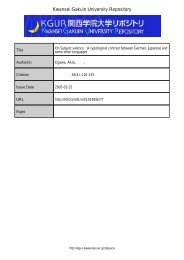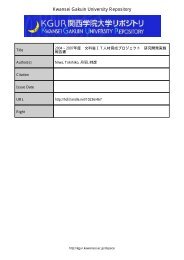Kwansei Gakuin University Repository
Kwansei Gakuin University Repository
Kwansei Gakuin University Repository
You also want an ePaper? Increase the reach of your titles
YUMPU automatically turns print PDFs into web optimized ePapers that Google loves.
exit of new firms of regional agglomeration (AGGLOM), defined as the number<br />
of establishments by the two-digit SIC level per square kilometer at the prefecture<br />
level.<br />
The effect of the variable for unemployment rate (UNEMP ) is also examined<br />
to control for regional economic conditions. 16 Unemployment rate has often been<br />
used as a measure of economic distress in regions (e.g., Storey, 1994; Acs et al.,<br />
2007). As is often argued, a higher unemployment rate may indicate lower levels of<br />
demand in regions. We expect the unemployment rate would negatively affect the<br />
performance of region-specific businesses, and thus new firms in regions with higher<br />
unemployment rates may be more likely to be forced to exit. On the other hand,<br />
Brixy and Grotz (2007) argue that an unfavorable labor market is associated with<br />
low opportunity costs because of a lack of alternatives. Therefore, it is predicted that<br />
entrepreneurs are less likely to dissolve their businesses voluntarily in economically<br />
distressed regions, because they do not have any other employment option. The<br />
variable for unemployment rate is calculated as the ratio of the unemployed to the<br />
labor force in each prefecture.<br />
With respect to firm-specific characteristics, the effect of firm size is examined<br />
as a determinant of exit. 17 A large number of studies have provided evidence that<br />
the probability of survival increases with firm size (e.g., Audretsch, 1991; Audretsch<br />
and Mahmood, 1991; Audretsch and Mahmood, 1995; Honjo, 2000a, Honjo, 2000b).<br />
Previous literature suggests a number of reasons that larger firms are more likely to<br />
survive than smaller firms. Audretsch and Mahmood (1995) argued that larger firms<br />
may be more likely to be closer to the minimum efficient scale to operate efficiently<br />
in a market, and are therefore less likely to be vulnerable than smaller firms that<br />
16 The effect of population growth was estimated to control for regional demand. A number of<br />
studies have found that population growth is an important determinant in new-firm survival. Acs et<br />
al. (2007) argued that high population growth regions are attractive for doing business, because the<br />
growth may enable firms to expand their businesses or create new businesses. However, because of<br />
the correlation between this variable and other variables, we do not report results for this variable.<br />
17 It should be noted that data on the number of employees are not measured at the year of entry,<br />
because the TSR Data Bank provides only the latest information on the number of employees.<br />
16
















